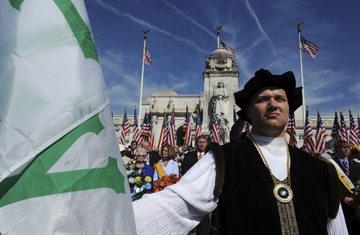
Jack Heretik of the Knights of Columbus portrays the 15th century Italian explorer Christopher Columbus during a Columbus Day event in Washington, D.C., on Oct. 11, 2010
Pity poor Leif Ericsson. The Viking explorer may well have been the first European to reach the Americas, but it is a certain Genoan sailor who gets all the glory. Thanks to evidence that has until now consisted only of bare archeological remains and a bunch of Icelandic legends, Ericsson has long been treated as a footnote in American history: no holiday, no state capitals named after him, no little ditty to remind you of the date of his voyage. But a group of Icelandic and Spanish scientists studying one mysterious genetic sequence — and one woman who's been dead 1,000 years — may soon change that.
Ten years ago, Agnar Helgason, a scientist at Iceland's deCODE Genetics, began investigating the origin of the Icelandic population. Most of the people he tested carried genetic links to either Scandinavians or people from the British Isles. But a small group of Icelanders — roughly 350 in total — carried a lineage known as C1, usually seen only in Asians and Native Americans. "We figured it was a recent arrival from Asia," says Helgason. "But we discovered a much deeper story than we expected."
Helgason's graduate student, Sigridur Sunna Ebenesersdottir, found that she could trace the matrilineal sequence to a date far earlier than when the first Asians began arriving in Iceland. In fact, she found that all the people who carry the C1 lineage are descendants of one of four women alive around the year 1700. In all likelihood, those four descended from a single woman. And because archeological remains in what is Canada today suggest that the Vikings were in the Americas around the year 1000 before retreating into a period of global isolation, the best explanation for that errant lineage lies with an American Indian woman: one who was taken back to Iceland some 500 years before Columbus set sail for the New World in 1492.
"Quantitatively, the importance of the discovery is fairly minimal," says Carles Lalueza, a researcher at Barcelona's Institute of Evolutionary Biology, who collaborated on the project. "You're talking about a few people on a remote island. But qualitatively, the fact that there is evidence for the transmission of genes between two continents at that early a date is very exciting."
And it's not just the mere fact of contact that is intriguing. Until now, the historical evidence has suggested that while the Vikings may have reached the Americas, they didn't really engage with the indigenous population. "According to the sagas, the Vikings had troubles with the locals and couldn't settle there, so they returned to Iceland," says Helgason. "But if we're right, it will mean they didn't just sail there and come back. They had real contact with them."
For now, the story of the lone American Indian woman taken on a Viking ship to Iceland remains a hypothesis. To prove it will require finding the same genetic sequence in older Amerindian remains elsewhere in the world — family members, as it were, of that 1,000-year-old woman who ended up so far from home. That sounds like a daunting task, but Helgason and his team hope that as news of their finding spreads, other geneticists will re-examine remains they have already studied for evidence of the same lineage.
In the meantime, Helgason will also be exploring one other possible explanation for the unexpected finding. Though unlikely, the presence of the C1 lineage could indicate that it originated in those ancient populations who dispersed from Europe into Asia and the Americas. In other words, instead of a single American Indian carrying the lineage to Europe, it may have risen out of primitive Europe and migrated to different parts of the world. "If that's the case, we'd be talking about 14,000 years ago," says Helgason. "So even if we're wrong about this one Amerindian woman, the other answer would be even more spectacular."
